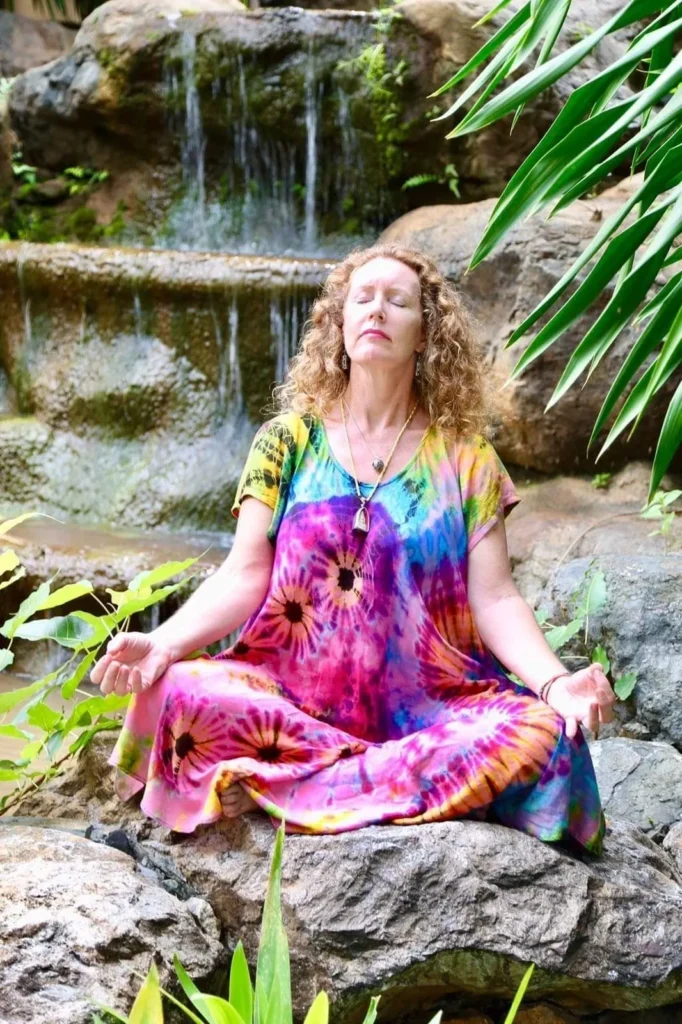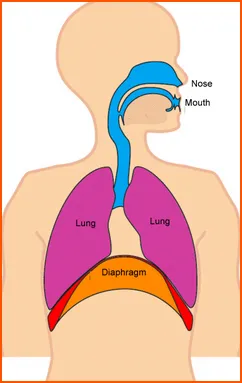
Breathe Deep & Free
Pranayama is the original name for Breathwork.
Pranayama is control of Breath. Prana is breath or vital life-force energy in the body. On subtle levels prana represents the subtle energy that runs through all life. Ayama means expansion or breadth. Pranayama is more than the expansion of breath, it is the conscious expansion of your life force energy.
Practicing pranayama can benefit the mind and body in many ways and on many levels, including physical, mental, emotional, and spiritual. Take it slowly. Build on your experience as you develop your breath control. As you relax and breathe consciously, yet effortlessly, you will begin to free your mind.
The mind is attracted to rhythms, the breath is the most natural rhythm found in life.
These meditations bring the mind into the present. The mind is always trying to move between the past and the future. In the present, there is no need for the mind, one can exist in awareness. By focusing the mind long enough in the present, the mind dissolves and becomes pure consciousness.
When thoughts pop up and we miss the breath, simply bring the mind back to the practice. Do not dwell on the thoughts, or get upset that thoughts keep arising. Bring the mind back to the meditation. Gradually the thoughts will diminish. Remember that you aren’t trying to punish your mind by not thinking. you are simply letting the thoughts pass through your mind while you are breathing.
A caution before you begin:
Never overdo any breathing exercise. If you begin to feel uncomfortable, or dizzy, go back to your everyday breath. Never force your breath to do anything it doesn’t want to do. If unpleasant feelings become more unpleasant, or your body becomes uncomfortable with the practice, then that is time to return to your usual breathing pattern.
Your breath possesses an innate intelligence, honed over millions of years of evolution. Learn to trust its messages.
The Therapeutic Reason Behind Pranyama
Why is control of breath so Important? What happens when you breathe? When you breathe, your lungs fill with air, blood travels through your heart picking up oxygenated blood and exchanging carbon dioxide. Oxygen and carbon dioxide travel around the body in the blood.
In stressful times we typically breathe too rapidly. This leads to a build-up of oxygen in the bloodstream and a corresponding decrease in the relative amount of carbon dioxide, which in turn upsets the ideal acid-alkaline balance – the pH level of the blood. This condition, known as respiratory alkalosis, can result in anxiety, nausea, irritability, light headedness, confusion and, muscle twitching.
In contrast, slowing the breath raises the carbon dioxide level in the blood, which nudges the pH level back to a less alkaline state. As the blood’s pH changes, the parasympathetic nervous system calms us and lowers the heart rate.
Breathing into a paper bag reduces the oxygen and increases the carbon dioxide being taken back into the body to help calm an anxiety attack.
Your breath can be a powerful ally in coping with temporary physical and emotional states – whether you’re despondent because of an argument, apprehensive about an upcoming job interview, exhausted after a tough day at work, or upset because of someone else’s attitude.
Each condition responds best to its own special breath. To calm anxiety, you can purposely lengthen your exhalations; to alleviate dullness and fatigue, you can lengthen your inhalations; to lift yourself out of an emotional pit, its most effective to equalize the lengths of your inhalations and exhalations.
Working with the Breath
Sit for a few minutes with your awareness on your body, your senses and sensory perceptions of your environment. Then move your awareness on your breath. Use your breath and your senses to anchor you in the present moment. Keep your awareness partly on your breath, partly on your body and partly on your environment. Let your awareness rest lightly on your breath. You don’t need to alter your breath, just breath naturally, in and out.
Feel your breath moving in and out of your body, the feel of the air as it moves in your nostrils as you inhale, down your throat and the movement of your chest as you breathe in and out.
Notice thoughts that arise. Notice and accept these thoughts without judgment. Thoughts are not bad or good, positive or negative, they just are what they are – the thought that you happen to be having at this particular moment. Sometimes there are many thoughts, one overlapping the next: memories, plans, fantasies. There may seem to be no gaps at all in which you can catch a glimpse of your breath. That’s not uncommon, especially if you’re new to meditation. Just notice what happens without judgement.
If you find yourself so caught up in thoughts that you have forgotten that you’re sitting in the room, just gently bring yourself back to the breath. Notice that your have been thinking, but don’t worry about it, just make a neutral observation: “Thinking has just occurred.”
If you are new to meditation, try to sit for 10 to 15 minutes and gradually increase to 20 or 30 minutes. Eventually, you could extend it to 45 minutes or an hour.
Mindfulness meditation is about noticing what arises, it is not about trying to make your mind become blank or trying to stop the mind from thinking. So, if you find you are thinking (and you will), include it in what you notice, but don’t well on the thoughts, let them flow freely. Don’t try to get rid of your thoughts, just notice them and let them go.
Be with yourself as you already are. We are not trying to change ourselves into some preconceived notion of how we ought to be.
Altering the Breath with alternate Nostril Breathing
Alternate nostril breath can calm an agitated mind. It can slow down a speeding mind. It can help with a headache by cooling the mind. It is a very safe and easy breathing technique that is a very handy breathing technique that only takes a few minutes to feel its therapeutic effects.
Nadi Shodhana
Nadi means channel and shodhana means cleansing or purifying. Nadi shodhana –
• Improves our ability to focus the mind
• Supports our lungs and respiratory functions
• Restores balance in the left and right hemispheres of the brain,
• Clears the energetic channels
• Rejuvenates and purifies the nervous system
• Removes toxins
• Settles stress
• Can help with headaches
Take a comfortable seat, with a straight spine and your heart and lungs open.
Nadhi Shodhana Breath Cycle
Left nostril Right nostril
| 1. inhale | → | 2. retention | → | 3. exhale |
| ↑ | ↓ | |||
| 6. exhale | ← | 5. retention | ← | 4. inhale |
. Relax your left palm comfortably into your lap or on your knee. You can use the fingers on your left hand to count your round, if you want to.
2. Bring the first and second fingers of your right hand to rest between your eyebrows, using them as a light anchor.
3. The fingers we’ll be actively using are the thumb and ring finger.
4. Close your eyes and take a deep breath in and out through your nose.
5. Close your right nostril with your right thumb. Inhale through the left nostril slowly and steadily.
6. Close the left nostril with your ring finger so both nostrils are held closed; retain your breath at the top of the inhale for a brief pause.
7. Open your right nostril and release the breath slowly through the right side; pause briefly at the bottom of the exhale.
8. Inhale through the right side slowly.
9. Hold both nostrils closed (with ring finger and thumb).
10. Open your left nostril and release breath slowly through the left side. Pause briefly at the bottom.
11. Repeat 5-10 cycles, allowing your mind to follow your inhales and exhales.
Try to match the length of your inhales, pauses, and exhales. For example, you can start to inhale for a count of five, hold for five, exhale for five, hold for five. You can slowly increase your count as you refine your practice.
In time you can try varying the ratio, see if it makes you feel differently. Find what works for you.
Try inhaling L 4, hold for 4, exhale R for 4 hold out for 4. 4:4:4:4 will open your mind to step out of time Or inhale L 4, hold 6, exhale R 4. inhale without holding the exhale 4:6:4 will ground you and calm an agitated mind
Pranayama
Ujjayi Breathing – Victorious Breath
Its name comes from the Sanskrit word “ujjayi,” which means “to conquer” or “to be victorious” therefore it is also often referred to as “Victorious Breath.” Because of the sound it makes when performed correctly, this breath is also sometimes called “Ocean Breath”. Ujjayi Pranayama is a breathing technique that helps calm the mind and warm the body. When practicing Ujjayi, you completely fill your lungs, while slightly contracting your throat, and breathe through your nose.
Benefits of Ujjayi Breath It is the breath that is used through yoga and can be used in other aerobic exercises. By controlling your breath, you calm your mind and bring awareness to the present moment, the steadiness, sound, and depth of the Ujjayi breath help to link your mind, body, and spirit to the present moment. Regularly practicing Ujjayi breath can help you release pent-up emotions. The extra oxygen and deep exhalations invigorate and strengthen. Ujjayi is particularly beneficial for calming the mind. It is known to be beneficial for those suffering from stress, insomnia, and mental tension.
Cautions When practicing Ujjayi Pranayama, be careful not to tighten your throat. Do not attempt any breathing exercise for the first time if you have a respiratory condition, such as asthma or emphysema. Stop the exercise if you become faint or dizzy. Always work within your own range of limits and abilities.

Instructions Begin seated in a comfortable position. Relax your body and gently close your eyes. Let your mouth drop open slightly. Relax your jaw and your tongue. Inhale and exhale deeply through your mouth. Feel the air of your inhalations passing through your windpipe. On your exhalations, slightly contract the back of your throat, as you do when you whisper. Softly whisper the sound, “ahhh,” as you exhale. Imagine your breath fogging up a window.
As you become comfortable with your exhalations, maintain the slight constriction of the throat on your inhalations, as well. You will notice your breath making an “ocean” sound, softly moving in and out, like ocean waves.
When you can comfortably control your throat during the inhalations and exhalations, gently close your mouth and begin breathing only through your nose. Keep the same constriction in your throat as you did when your mouth was open. You will continue to hear the “ocean” sound as you breathe through your nose. Direct the breath to travel over your vocal cords, across the back of your throat. Keep your mouth closed, but your lips soft.
Concentrate on the sound of your breath; allow it to soothe your mind. It should be audible to you, but not so loud that someone standing several feet away can hear it. Let your inhalations fill your lungs to their fullest expansion. Completely release the air during your exhalations. Start by practicing Ujjayi for five minutes while you are seated. For deeper meditation, increase your time to 15 minutes.
Tips When practiced correctly, Ujjayi breath will both energize and relax the body, mind, and spirit. The breath should be steady, rhythmic, smooth, and full. The “ocean” sound should soothe your mind. Throughout your practice, keep the steadiness, length, and smoothness of your breath as much as you can.